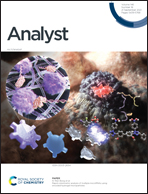Novel recognition mechanism based on oxidative addition of Pt(ii) complex-based luminescent probes for hypochlorite ion detection†
Abstract
Platinum(II) complexes are the most commonly used anticancer drugs and potential optical materials, but the detectability of Pt(II) complex-based probes is seldom reported. In our previous work, a tetradentate Pt(II) complex Pt-CHO was utilised as a ‘turn-off’ probe to detect ClO− and image cancer cells. However, the recognition mechanism has not been completely clarified and there are still doubts. In this work, three Pt(II) complexes, Pt-H, Pt-CHO and Pt-COOH, were developed to elucidate the mechanism of this class of complexes and refine their property studies. As a result, the UV–visible absorption and luminescence emission experiments, as well as the mass spectrum, proved that the oxidation of Pt(II) to Pt(IV) was the real reason for luminescence quenching, which has nothing to do with aldehyde groups. This first reported mechanism introduces a new type of ClO− probe based on Pt(II) complexes, thereby expanding the application fields of platinum complexes. Moreover, the quantum yield measurements, the effect of biomolecules and reversibility were studied to improve the properties of the probes. Theoretical calculations were used to gain an in-depth understanding of optical characteristics and related mechanisms. The cell imaging of RAW264.7 cells under endogenous ClO− proved the potential of the probes in bioimaging.



 Please wait while we load your content...
Please wait while we load your content...